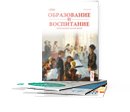A child with an intellectual disability does not single out a peer as an object of interaction for a long time. Therefore , the process of mastering cooperative skills and means of interpersonal interaction is slow and difficult.
Based on the conducted research, it is noted that in a situation of disorganized play activity, mentally retarded preschoolers use mainly two forms of communication. For the majority of older preschool children with intellectual disabilities , an extra- situational and cognitive form of communication is characteristic, while the rest of the children resort to an even more primitive situational and business form. They do not have the non- situational personal form of communication that is typical for normally developing children of the same age.
The formation of communicative skills cannot but be affected by the fact that the motivational and need sphere of mentally retarded preschoolers is at the initial stage of formation. Their interests are closely related to the entertainment of the activity performed, they are not intense, shallow, one- sided, situational, undifferentiated and unstable, caused mainly by physiological needs. Children are guided, as a rule, by immediate motives. Many researchers note as a characteristic feature of a mentally retarded child his lack of interest in learning. His impulsive reactions, of course, cannot be assessed as an interest in this or that object.
Keywords: intellectual disability, forms of communication, motivational and need sphere, interest in learning
Introduction. Communication of an abnormally developing child goes through the same stages as communication of a child with normal intelligence, but with a number of differences and developmental delay. Let's consider some features of the development of children with intellectual disabilities, which characterize the originality of their communication. Children with intellectual disabilities have a peculiar emotional and socio-personal development. Among the diverse personality traits, an essential place belongs to emotions, which influence any manifestation of human activity. Whatever factors determine a person's life and activity, they become psychologically effective only when they penetrate into the sphere of emotional relationships. L. S. Vygotsky, among the oligophrenic kids entering preschool, who expressed the idea of close interaction and internal unity of the intellectual and emotional spheres, believed that a child with mental retardation has a different ratio between intelligence and affect than normal, and it is this characteristic that is important for understanding the uniqueness of his psyche. A violation of the adequacy of emotional reactions manifests itself at an early age. So, according to O. P. Gavrilushkina, there is an indifference to the mother. Children don't even always recognize her, they don't distinguish her from other adults. There is no reaction to a smile and affectionate treatment. Thus, the line of communication development is distorted already at the stage of formation of a situational and personal form.
The untimely and difficult emotional contact of a mentally retarded child with close adults negatively affects the formation of more complex forms of communication. As a rule, all mentally retarded preschoolers have a lack or significant decrease in interest in the environment, general pathological inertia. They do not have a timely transition to communicating with adults on the basis of joint actions with toys, a new form of communication does not arise, typical of infancy in the norm — situational and business. Thus, the process of forming the «WE» system is delayed in children of the category under consideration, which is the result of business cooperation between an adult and a child and consists in the fact that not only the adult seeks to transfer his experience, but also the child wants and can learn it. The ways of assimilation of social experience are very diverse, these include: joint actions of an adult and a child, the use of expressive gestures, especially pointing («gesture instruction»), imitation of adult actions, actions according to a pattern. As a result, the separation of one's own «I» from the «WE» system is not only delayed in time, but has its own specific features. So, by the beginning of preschool age, when a normally developing child of 3 years old begins to realize his own «I», a mentally retarded child has practically no personal manifestations yet, his behavior is involuntary. After 4 years, when the mentally retarded begin to develop an interest in the environment, elementary actions with objects are formed, the first manifestations of self-awareness, separation of their «I«arise, which are expressed, as a rule, in negative reactions to remarks, censures, failure.
The peculiarities of speech communication of children with intellectual disabilities are due to a specific violation of their speech, manifested against the background of a deep violation of cognitive activity, abnormal mental development in general. Researchers such as A. K. Aksenova, M. F. Gnezdilov, A. G. Zikeev, R. I. Lalaeva, V. G. Petrova and others studied the oral speech of mentally retarded schoolchildren. There is widespread evidence in the specialized literature that mentally retarded children, having neither hearing damage nor sharp anomalies in the structure of speech organs, master speech much later than their normally developing peers. In studies devoted to the peculiarities of the development of students with intellectual disabilities, there is a lot of factual material showing that one or another mentally retarded child began to pronounce the first words not in a year and a half, but only in the third, fourth and even fifth year of life. In addition, mentally retarded children switch to using sentences later than is the case with normal development. Short agrammatic phrases appear by the age of five or six. Some psychologists believe that this transition is more significant for assessing the level of a child's speech development than pronouncing his first words. There is evidence that in the mentally retarded, the appearance of the first words is separated from the use of sentences by a much longer time interval than is the case normally [1].
They understand the speech addressed to them much worse than their normal peers. The questions, demands, explanations and instructions of adults play a slightly different, less effective role in their lives. If the statements of the interlocutor are long, then children quickly get tired and stop listening. This is especially pronounced in cases where there are no specific supports that attract the attention of children and help them understand what an adult wants from them. A. A. Kataeva, E. A. Strebeleva notes that mentally retarded children are not always familiar with the meanings of the words included in the instructions. They may not accurately understand the meaning of words defining the object with which to act, its properties, spatial location or relationship between objects, or words denoting the actions themselves, the direction of movement, etc. Mentally retarded children especially poorly perceive instructions describing the order of actions (first, then) and methods of action. In children, the planning function of speech normally appears by the older preschool age.
In children with intellectual disabilities without special correctional work, it does not occur at all within the preschool age. By the end of four years, the delay in expressive speech (for 27–29 months) and impressive (for 24–28 months) is most pronounced.
The peculiarities of the vocabulary of mentally retarded children include poor vocabulary, inaccuracy of the use of words, difficulty in updating the dictionary, a more significant than normal predominance of the passive dictionary over the active one, as well as the unformed structure of the word meaning, violation of the process of organizing semantic fields. The underdevelopment of the grammatical side of speech is manifested in agrammatism, violation of the consistency of words in sentences, the predominance of simple syntactic constructions in speech, insufficient morphological forms of inflection and word formation. At school age, they often use situational speech, understandable only to those who know the circumstances they are trying to report. Often, persons and places of events are replaced by pronouns, which not only impoverish speech, but also make it incomprehensible. Sometimes children, starting to speak, do not have time to come up with the completion of a phrase and end with words that do not agree with the beginning.
At the present stage, communication is considered as the main condition for the development of a child, as it provides the process of inheritance of the socio-cultural experience of generations, is the most important factor in personality formation, one of the main types of human activity aimed at cognition and self-assessment through the medium of other people. Within the framework of our research, the consideration of communication in the activity paradigm is the most effective. Understanding communication as an activity allows you to understand the internal mechanisms of the process, its individual essence, conduct a thorough analysis of it, highlighting and characterizing the main structural components. The external manifestation of communication is acts of communication, communicative acts, for the emergence and implementation of which it is necessary to have a number of mandatory conditions. Information is transmitted through sign systems. It is customary to distinguish two types of communication depending on the sign systems used: verbal and non-verbal. Speech communication is of particular interest for experimental research. From the point of view of the activity approach, communicative skills should be correlated not with operations, but with communication actions, their formation implies not only possession of means of communication, but also the ability to freely and adequately use these means in the changing conditions of natural live communication. The skills necessary for a person to carry out communication, which are defined as communicative and verbal, include orientation in a communication situation (awareness of what the statement will be about, to whom it is addressed, under what circumstances, why it is created, what is the main idea and theme of the statement), planning the content of the message (the ability to determine the beginning of the statement, its plan, to make the transition from one thought to another), the ability to formulate one's own thoughts (to select linguistic means corresponding to the content of the utterance) and to understand others', the ability to exercise self-control over speech, the perception of it by the interlocutor, as well as the understanding of the partner's speech [2–3].
A communicative skill is a communicative action that has reached a degree of perfection: the skills of understanding spoken speech, the skills of making statements (the process of speaking) — external design; and the listening process — internal design.
The emergence and development of speech in children occurs in the process of their communication with other people and is conditioned by the needs of communication and the general life of the child. The process of mastering speech goes through a number of stages.
The communicative activity of children with mental retardation goes through the same stages as the communication of a child with normal intelligence, but with a number of differences and developmental delay.
The peculiarities of speech communication of children with intellectual disabilities are due to a specific violation of their speech, manifested against the background of impaired cognitive activity, abnormal mental development in general. The failure of speech communication in mentally retarded children is associated not only with intellectual and speech disorders, but also with the lack of communication technologies with adults and peers. Children with intellectual disabilities are actually limited in the possibilities of verbal communication, since the acquired speech means are not designed to meet the need for communication.
Currently, children are increasingly experiencing various intellectual disabilities, burdened with concomitant defects, which in turn makes it most difficult to teach and makes it difficult to master the basic educational program without creating special educational conditions.
Communication, as a fundamental condition for the development of a child, is an essential component of the formation of his personality. Children with intellectual disabilities experience significant difficulties in communication: speech appears in children much later than in children with normal development, in other cases it may not appear. The quality of speech, of course, suffers, as there is a persistent underdevelopment of almost all its components. Intellectual impairment is of a total nature, which causes a violation of communication as a result of violations of higher mental functions. Depending on the degree and localization of brain damage, speech disorders of various severity may manifest themselves.
Violations such as echolaric speech are noted — this is mechanically reproducible speech, meaningless speech. Children with intellectual disabilities do not understand other people's speech well, they can catch the tone, intonation, facial expressions of the speaker and individual reference words related to their everyday needs. The active vocabulary is marked by poverty, which consists of words and expressions often used in everyday life, and is characterized by stamps. Further enrichment of the dictionary is extremely difficult, due to the stiffness of nervous processes. Words are rarely fully used in the process of communication. The grammatical structure is grossly violated and monosyllabic phrases with broken coordination in sentences are more often used. Children with moderate mental retardation use situational speech, understandable only to those present. Speech disorders are systemic in nature [4–5].
Thus, it is advisable in the process of speech therapy to organize holistic and systematic training aimed at the formation of speech competence, which includes the development of children's communicative and linguistic abilities.
It is important in the process of speech therapy work to activate all analyzers to achieve the maximum possible results. Learning is structured in such a way that the object being studied is perceived by all the senses, if possible. Here we can use the following techniques: verbal, visual, and playful.
Their use allows students to take an active part in the learning process, deepen knowledge and share it, increase interest in the material being studied, promotes the development of coordination of movements, eye contact, speech and communication skills, which significantly improves the results of speech therapy work.
The formation of communicative skills is organically included in all types of activities and is implemented on the basis of games and exercises offered by other areas of the program. Improving the level of communication skills is both an independent goal and a means to achieve significant success in all areas of development of children with moderate intellectual disabilities.
Thus, the areas of work on the formation of communicative skills in younger schoolchildren with moderate intellectual impairment are: the development of emotional reactions (the presence of emotional contact between the child and the teacher); the purposeful formation of the communicative function of speech (the development of understanding and the expansion of passive vocabulary): activation of imitative activity; activation of speech imitation; expansion of the scope of understanding speech; use of elements of alternative communication technology (working with pictograms).
The directions of work on the formation of communication skills in younger schoolchildren with moderate intellectual disability are shown in Figure 1.

Figure 1. Directions of work on the formation of communication skills in younger schoolchildren with moderate intellectual disability
Thus, the work on the formation of communication skills in younger schoolchildren with a moderate intellectual disability is characterized by great specificity, which is due to the peculiarities of higher nervous activity, psychological characteristics, as well as symptoms, mechanisms, and structure of the defect in this category of children.
References:
- Гвоздев, А. Н. Вопросы изучения детской речи / А. Н. Гвоздев. — СПб.: Детство-пресс, 2007. — 472 с.
- Зикеев, А. Г. Развитие речи учащихся специальных (коррекционных) образовательных учреждений: учеб. пособие для студ. высш. пед. учеб. заведений. — М.: Академия, 2000. — 200 с.
- Кириллова, Е. В. Формирование предпосылок коммуникативной деятельности у безречевых детей: дисс.... канд. пед. наук: 13.00.03 / Кириллова Елена Владимировна. — М., 2001. — 202 с.
- Гнездилов, М. Ф. Развитие устной речи умственно отсталых школьников. — М.: Педагогика, 1947. — 135 с.
- Дмитриева, Л. И. Формирование словаря у учащихся специальных (коррекционных) школ VIII вида (начальные классы): учебное пособие. — М.: Московский психолого-социальный институт, 2002. — 128 с







